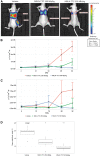Advances in Precision Oncology: Targeted Thorium-227 Conjugates As a New Modality in Targeted Alpha Therapy
- PMID: 32255671
- PMCID: PMC7475103
- DOI: 10.1089/cbr.2020.3568
Advances in Precision Oncology: Targeted Thorium-227 Conjugates As a New Modality in Targeted Alpha Therapy
Abstract
Targeted α therapy (TAT) offers the potential for the targeted delivery of potent α-particle-emitting radionuclides that emit high linear energy transfer radiation. This leads to a densely ionizing radiation track over a short path. Localized radiation induces cytotoxic, difficult-to-repair, clustered DNA double-strand breaks (DSBs). To date, radium-223 (223Ra) is the only TAT approved for the treatment of patients with metastatic castration-resistant prostate cancer. Thorium-227 (227Th), the progenitor nuclide of 223Ra, offers promise as a wider-ranging alternative due to the availability of efficient chelators, such as octadentate 3,2-hydroxypyridinone (3,2-HOPO). The 3,2-HOPO chelator can be readily conjugated to a range of targeting moieties, enabling the generation of new targeted thorium-227 conjugates (TTCs). This review provides a comprehensive overview of the advances in the preclinical development of TTCs for hematological cancers, including CD22-positive B cell cancers and CD33-positive leukemia, as well as for solid tumors overexpressing renal cell cancer antigen CD70, membrane-anchored glycoprotein mesothelin in mesothelioma, prostate-specific membrane antigen in prostate cancer, and fibroblast growth factor receptor 2. As the mechanism of action for TTCs is linked to the formation of DSBs, the authors also report data supporting combinations of TTCs with inhibitors of the DNA damage response pathways, including those of the ataxia telangiectasia and Rad3-related protein, and poly-ADP ribose polymerase. Finally, emerging evidence suggests that TTCs induce immunogenic cell death through the release of danger-associated molecular patterns. Based on encouraging preclinical data, clinical studies have been initiated to investigate the safety and tolerability of TTCs in patients with various cancers.
Keywords: 227Th; conjugate; precision oncology; targeted alpha therapy.
Conflict of interest statement
All are employees of Bayer.
Figures




References
-
- Baudino TA. Targeted cancer therapy: The next generation of cancer treatment. Curr Drug Discov Technol 2015;12:3. - PubMed
-
- Mukherjee S. The Emperor of All Maladies: A Biography of Cancer. New York: Scribner, 2010
-
- Haberkorn U, Giesel F, Morgenstern A, et al. . The future of radioligand therapy: Alpha, beta, or both? J Nucl Med 2017;58:1017. - PubMed
Publication types
MeSH terms
Substances
LinkOut - more resources
Full Text Sources
Research Materials
